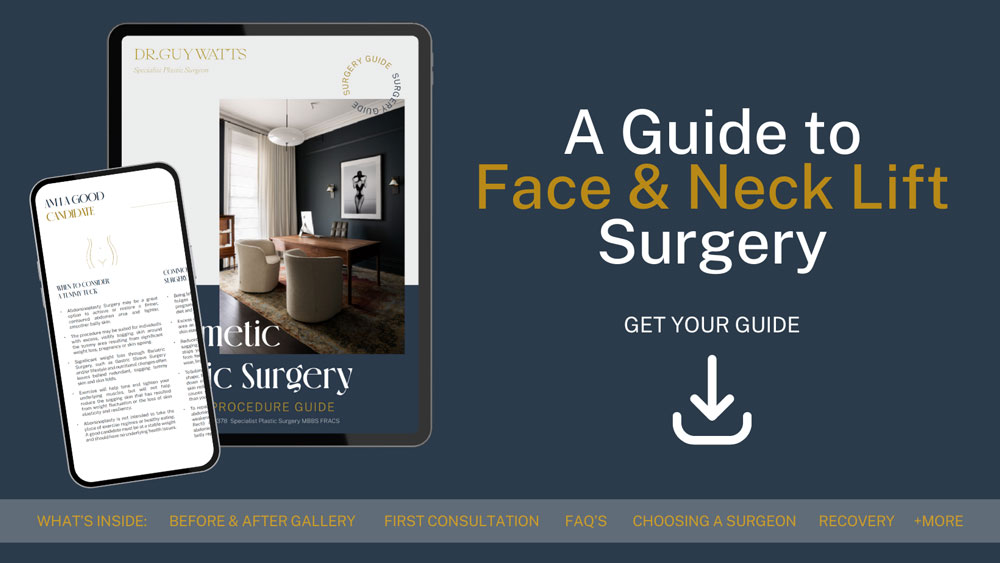
12 Jul Recovery after Facelift Surgery
Post-Operative Timeline and Tips for Recovery after Facelift
Facelift surgery is a complex plastic surgery procedure that addresses lax skin and wrinkles at the level of the face. While the surgical phase is crucial, it is equally important to pay attention to your post-operative recovery. The recovery period plays a significant role in optimising healing, reducing complications and achieving long-lasting results.
In this blog, Perth Specialist Plastic Surgeon Dr. Watts will guide you through the post-operative timeline of Facelift surgery and provide you with tips to facilitate your recovery.
Take our quiz, and find out if you are ready for surgery
Preparing for a Successful Recovery
Before undergoing Facelift surgery, it is essential to have thorough consultations with Dr. Watts. These consultations allow you to discuss your expectations, understand the procedure, and ask any questions or concerns you may have. Dr. Watts will also provide you with specific pre-operative instructions that are tailored to your individual needs.
Following these pre-operative instructions is crucial. These instructions may include guidelines on medications to avoid, dietary restrictions, and steps to prepare your skin for the procedure. By diligently adhering to these instructions, you can make sure that your body is in optimal condition for surgery.
Preparing Your Home for Recovery after Facelift
Setting up a comfortable and supportive environment at home is essential for your post-operative recovery. Before your surgery, take the time to prepare your home environment to reduce any stress or discomfort during the healing process.
Before anything else, designate a recovery space that is clean, quiet, and easily accessible. Arrange comfortable pillows and cushions to support your head and neck as you rest. Consider placing essentials within arm’s reach, such as medications, water, and entertainment options like books or magazines.
Stock up on necessary supplies before your surgery. This includes items like gauze, sterile dressings, antibiotic ointment, and prescribed medications. Having these supplies readily available will allow you to focus on your recovery without the added stress of rushing to the pharmacy.
By taking these preparatory steps, you can help your transition from the surgical centre to your home, promoting a comfortable and stress-free recovery.
DOWNLOAD YOUR FREE GUIDE TO FACE AND NECK LIFT SURGERY

The First 24 Hours after Facelift Surgery
The initial 24 hours following Facelift surgery are critical for your recovery. During this time, patients can expect to experience some swelling, bruising, and discomfort. You will likely have bandages and dressings in place to protect the incision sites.
Rest is essential during this period. Make sure to relax and avoid any strenuous activities. Dr. Watts may advise you to keep your head elevated to help reduce swelling and promote proper blood circulation. Follow his instructions regarding the use of compression garments or ice packs to reduce swelling.
It’s important to have someone stay with you during the first 24 hours to assist you, as you may feel groggy from the anaesthesia. Keep in mind that your energy levels may be lower than usual, so be patient with yourself and prioritise rest.
Discomfort and Pain after Facelift Surgery
Facelift surgery involves some degree of discomfort during the initial recovery phase. Dr. Watts will prescribe pain medication to manage any post-operative discomfort. Take the medication as directed, and make sure to discuss any concerns or side effects with Dr. Watts.
In addition to medication, applying cold compresses to the surgical areas can help alleviate swelling and reduce discomfort. Follow Dr. Watts’ instructions regarding the frequency and duration of cold compress applications.
Remember, everyone’s pain tolerance and recovery experience will be unique. If you have any concerns about your level of pain or discomfort, don’t hesitate to reach out to Dr. Watts for guidance and reassurance.
Wound Care and Dressings
Proper wound care is crucial for optimal healing and reducing the risk of infection. Dr. Watts will provide specific instructions on how to care for your incision sites and change dressings. In some cases, advanced techniques such as haemostatic nets may be used to help control bleeding and support healing. Learn more about how haemostatic nets work in surgical recovery.
Generally, you will need to keep the incisions clean and dry. Dr. Watts may recommend a light cleansing routine using a mild, fragrance-free cleanser. After cleansing, pat the incisions dry and apply any prescribed antibiotic ointments or creams. Use a light touch when handling the incisions to avoid irritation or disruption of the healing process.
It is important to follow Dr. Watts’ guidelines for changing dressings. This may involve replacing dressings with fresh ones or removing them altogether. Make sure to wash your hands thoroughly before handling dressings or applying any ointments.
Recovery Timeline after Facelift Surgery
- Days 2-7
As you progress through the first week of your recovery, you can expect a gradual reduction in swelling and bruising. It is common to experience some tightness or discomfort in the facial area, which can be managed with pain medication as prescribed by Dr. Watts.
During this phase, it is essential to continue resting and avoiding strenuous activities. However, Dr. Watts may suggest that you engage in light activities such as short walks to promote blood circulation and prevent complications.
You may notice that your face feels somewhat numb or tingly during this time. This is to be expected and will gradually dissipate as your nerves heal. Follow Dr. Watts’ advice regarding when to start facial massages or lymphatic drainage techniques to aid in reducing swelling.
- Weeks 1-2
In the second week of your recovery, you will likely experience a significant reduction in swelling and bruising. As the initial discomfort subsides, you can gradually resume your daily activities, although it’s important to avoid activities that could strain your incisions or compromise your healing process.
Follow Dr. Watts’ recommendations regarding sun protection. It is essential to shield your face from direct sunlight and wear broad-spectrum sunscreen to protect your delicate skin from harmful UV rays.
During this phase, you may begin to notice the initial results of your surgery. However, it’s important to keep in mind that your final results will take time to appear as your tissue will need to settle and residual swelling will remain for some time.
- Weeks 3-6
As you enter the third to sixth week of your recovery, you will likely experience a further reduction in swelling and bruising. Your face will begin to feel more comfortable, and you can gradually reintroduce more activities, such as light exercise, as advised by Dr. Watts.
Continue to be mindful of your incision sites and avoid activities that could put excessive strain on them. Dr. Watts may provide specific guidelines for exercises or activities to avoid during this phase.
During this period, you will also have follow-up appointments with Dr. Watts to assess your progress. These appointments are an opportunity to discuss any concerns or questions you may have and make sure your recovery is on track.
Care and Results after Facelift Surgery
During your recovery, Dr. Watts will schedule follow-up appointments to monitor your progress and address any concerns. These appointments are crucial to make sure your healing is on track and any potential issues are promptly identified and addressed.
Use these appointments as an opportunity to discuss any questions or uncertainties you may have. Dr. Watts will assess the healing of your incisions, the overall progress of your recovery, and provide recommendations for further care.
As your recovery progresses, you will begin to see the final results of your Facelift surgery. It’s important to keep in mind that the ageing process will continue, and your face will change over time.
Recovering from Facelift surgery requires patience, dedication, and proper self-care. By following the post-operative timeline and implementing the tips provided in this blog, you can optimise your recovery. Remember to consult with Dr. Watts for personalised advice and guidance throughout your recovery journey.
FAQs about Recovery after Facelift

How long does it take to fully recover after a Facelift?
- The timeline for total recovery after a Facelift can vary depending on individual factors such as age, general health, and the specifics of the procedure performed.
- On average, most patients begin to look more like themselves within 2-4 weeks after the procedure.
- Swelling and bruising, (which are common post-operative symptoms), usually start to diminish within the first two weeks.
- It may take up to 6 months to a year for all the subtle changes to settle and for the final result to be fully apparent.
What to expect 4 weeks after Facelift?
- By the 4-week mark, the majority of the swelling and bruising should have subsided, and you’ll likely start to see the initial results of your procedure.
- Any stitches or sutures will likely have been removed by this point, and most patients feel capable of returning to their daily activities.
- Some slight swelling or numbness may still be present, and subtle changes will continue to occur as your body heals and adjusts.
Is Facelift recovery hard?
- Recovery from a Facelift is a highly individualised process and can be influenced by many factors such as the patient’s overall health, the specifics of their surgery, their age, skin health and lifestyle factors.
- A patient’s individual pain tolerance also affects how hard they will take the recovery period.
- The first few days to a week post-surgery are often the most uncomfortable, with swelling, bruising, and mild to moderate pain.
What not to do after a Facelift?
- After a Facelift, it’s essential to avoid any activities that can strain your incisions or increase your blood pressure, like heavy lifting or vigorous exercise, for at least two weeks.
- Smoking and alcohol should also be avoided as they can slow the healing process.
- It’s recommended to avoid direct sunlight and to use a high-SPF sunscreen on your face to protect healing skin.
- Lastly, don’t rush your recovery; give your body the time it needs to heal and refrain from resuming activities until Dr. Watts gives you the go-ahead.
Can I go back to work 2 weeks after a Facelift?
- Yes, most people can return to work two weeks after a Facelift, assuming their job does not involve strenuous physical activity.
- This can vary based on your healing process and the physically of your work.
- It’s also important to note that while major swelling and bruising will likely have subsided by this point, some swelling or changes in skin sensation may still be present.
- You should always discuss your return-to-work timeline with Dr. Watts.
Further Reading about Face Procedures with Dr. Watts
- Read Dr. Watts’ Facelift Surgery Page
- Read Dr. Watts’ Blepharoplasty Surgery Page
- Read Dr. Watts’ Chin Augmentation Surgery Page
- Read Dr. Watts’ Rhinoplasty Surgery Page
- See Dr. Watts’ Facelift Before and After Photos Gallery
- Read Dr. Watts’ blog about 7 Tips to Reduce Bruising after Facelift Surgery
- Read Dr. Watts’ blog about When to Resume Exercising after Facelift Surgery
Medical References about Facelift Recovery
About Dr. Guy Watts – MED0001539378
FRACS (Plas) – Specialist Plastic Surgeon In Perth WA

Dr. Guy Watts is a Specialist Plastic Surgeon (AHPRA MED0001539378) with an extensive career that spans across renowned plastic surgery clinics worldwide. His experience has been honed through invaluable experiences at esteemed establishments such as the New York Eye and Ear Infirmary and the renowned Pitanguy Clinic in Brazil.
Having collaborated with the foremost cosmetic plastic surgeons on a global scale, Dr. Watts has chosen to return to Perth after a 17-year journey of intensive training and invaluable professional experience to bring the latest practices and technology in cosmetic plastic surgery to his patients.
Dr. Watts is a Fellow of the Royal Australasian College of Surgeons (FRACS) and a Member of the Australian Society of Plastic Surgeons (ASPS), Australasian Society of Aesthetic Plastic Surgeons (ASAPS) and the International Society of Aesthetic Plastic Surgeons (ISAPS).
Read about the potential Risks and Complications of Surgery
Read the Patient Information and Resources
About CLINISPA
Clinispa is Dr Watts’ bespoke medical clinic performing Cosmetic Aesthetic treatments. At Clinispa, we offer advanced clinical treatments in a luxurious and calming environment, tailored to support your skin’s health and appearance.
Clinispa aesthetic services are performed by Dr Guy Watts’ nursing professionals, who have a passion for and solid understanding of facial aesthetics.
All Clinispa clients are considered individually, with a personalised treatment plan consisting of advanced scientific approaches to cosmetic aesthetics. We incorporate innovative technologies in conjunction with superiorly formulated skin care.
For more information about the full range of Clinispa Aesthetic of Cosmetic Treatments visit the Clinispa website







Sorry, the comment form is closed at this time.